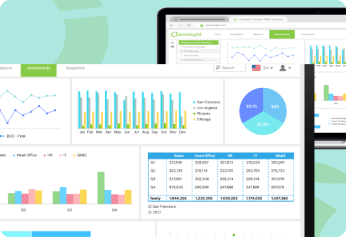Picture this: Your finance team just finished a grueling three-month budgeting process, only to watch market conditions shift dramatically two weeks later. Traditional annual budgets suddenly feel outdated, and you're left wondering how to stay ahead of rapidly changing business conditions.
This scenario plays out in boardrooms across industries every day. Finance leaders are discovering that static, point-in-time forecasts simply can't keep pace with today's dynamic business environment. That's where rolling forecasts come in—a flexible approach that keeps your financial planning current and actionable.
What is a Rolling Forecast?
A rolling forecast is a dynamic financial planning method that continuously updates projections by adding new periods as old ones are completed. Unlike traditional annual budgets that remain fixed, rolling forecasts maintain a consistent time horizon—typically 12 to 18 months—that "rolls" forward each month or quarter.
Think of it as a moving window into your company's financial future. When January ends, you don't just mark it complete—you add a new period (like next January) to maintain your forward-looking view. This approach ensures your forecasts always reflect the most current data and market conditions.
The key characteristic that sets rolling forecasts apart is their continuous nature. They're living documents that evolve with your business, incorporating real-time insights and adjustments rather than waiting for the next annual planning cycle.
Why Are Rolling Forecasts Important?
Rolling forecasts have become essential tools for modern finance teams because they address critical gaps in traditional planning methods. Here's why they matter:
- Real-time decision making becomes possible when your forecasts reflect current conditions rather than assumptions made months ago. Finance leaders can spot trends early and adjust strategies before problems become crises.
- Market responsiveness improves dramatically. When external factors shift—whether it's supply chain disruptions, economic changes, or competitive pressures—rolling forecasts help organizations adapt quickly rather than waiting for the next budget cycle.
- Resource allocation becomes more strategic. With continuously updated projections, teams can redirect investments, adjust hiring plans, and optimize spending based on the latest performance data and market intelligence.
- Stakeholder confidence increases when leadership sees that financial planning stays current with business realities. Board members and investors appreciate the proactive approach to financial management that rolling forecasts demonstrate.
Rolling Forecast vs. Traditional Forecast
Understanding the differences between rolling and traditional forecasts helps clarify why many organizations are making the switch:
|
Aspect |
Traditional Forecast |
Rolling Forecast |
|
Time Horizon |
Fixed annual period |
Continuous 12-18 months |
|
Update Frequency |
Annually |
Monthly or quarterly |
|
Flexibility |
Limited mid-year changes |
Continuous adjustments |
|
Data Currency |
Based on point-in-time assumptions |
Incorporates latest actual results |
|
Planning Effort |
Intensive annual process |
Distributed ongoing effort |
|
Accuracy |
Decreases over time |
Maintains relevance |
|
Resource Requirements |
Heavy front-loaded work |
Steady, manageable workload |
The most significant difference lies in adaptability. Traditional forecasts lock teams into assumptions that may quickly become outdated, while rolling forecasts embrace change as a constant factor in business planning.
Benefits of Rolling Forecasts
Organizations that implement rolling forecasts typically experience several key advantages:
- Enhanced accuracy results from incorporating actual performance data into future projections. Instead of relying on year-old assumptions, teams base forecasts on recent trends and current market conditions.
- Improved cash flow management becomes possible with more accurate short-term projections. Finance teams can better predict working capital needs, plan for seasonal variations, and optimize investment timing.
- Better strategic alignment occurs when financial plans stay synchronized with business strategy. Rolling forecasts make it easier to model the financial impact of strategic initiatives and adjust plans as priorities evolve.
- Reduced planning burden may seem counterintuitive, but many organizations find that spreading forecast updates throughout the year creates a more manageable workload than intensive annual planning sessions.
- Increased organizational agility enables faster responses to opportunities and threats. When forecasts stay current, decision-makers can act on reliable financial projections rather than outdated assumptions.
Challenges of Rolling Forecasts
While rolling forecasts offer significant advantages, they also present certain challenges that organizations must address:
- Resource intensity can be substantial, particularly during initial implementation. Teams need time to develop new processes, train staff, and establish regular update routines. The ongoing effort required for monthly or quarterly updates also demands dedicated resources.
- Technology requirements often exceed what traditional spreadsheet-based planning can handle effectively. Managing multiple scenarios, version control, and data integration typically requires specialized software solutions.
- Change management challenges arise when moving from familiar annual planning cycles to continuous forecasting. Staff may resist new processes, and organizations need strong change management strategies to ensure adoption.
- Data quality dependencies become more critical with frequent updates. Rolling forecasts require reliable, timely data feeds from various systems. Poor data quality can undermine forecast accuracy and user confidence.
- Over-reliance risks can develop when teams become too dependent on forecasts for decision-making. It's important to remember that even rolling forecasts are projections, not guarantees.
How to Implement a Rolling Forecast
Successfully implementing rolling forecasts requires careful planning and systematic execution. Here's a step-by-step approach:
Step 1: Define Your Forecast Horizon and Update Frequency
Choose a time horizon that matches your business needs—typically 12 to 18 months for most organizations. Decide whether you'll update monthly or quarterly based on your industry's pace of change and available resources.
Step 2: Select the Right Technology Platform
Evaluate whether your current systems can support rolling forecasts effectively. Many organizations find that spreadsheet-based approaches become unwieldy with frequent updates and multiple scenarios. Consider cloud-based FP&A platforms that offer automation, integration capabilities, and collaborative features.
Step 3: Identify Key Metrics and Drivers
Focus on the financial metrics that matter most to your business. This might include revenue by product line, key expense categories, headcount, and cash flow components. Identify the business drivers that influence these metrics.
Step 4: Establish Data Sources and Integration
Map out where your forecast data will come from—ERP systems, CRM platforms, HR systems, and external market data. Plan for automated data feeds where possible to reduce manual effort and improve accuracy.
Step 5: Design Your Forecast Model
Build models that can easily accommodate new periods and scenario planning. Ensure your structure supports both top-down strategic inputs and bottom-up operational details.
Step 6: Create Update Processes and Responsibilities
Define who will update which parts of the forecast and when. Establish clear deadlines, review processes, and approval workflows. Document procedures to ensure consistency.
Step 7: Pilot and Refine
Start with a pilot implementation covering key business units or metrics. Use the pilot period to refine processes, identify issues, and build confidence before full rollout.
Rolling Forecast Best Practices
Successful rolling forecast implementations share several common characteristics:
- Regular review cycles ensure forecasts stay relevant and accurate. Schedule monthly or quarterly review sessions with key stakeholders to discuss assumptions, identify trends, and make necessary adjustments.
- Scenario planning integration helps teams prepare for different potential outcomes. Build multiple scenarios into your rolling forecasts to model optimistic, realistic, and conservative cases.
- Driver-based modeling improves forecast accuracy by linking financial outcomes to underlying business drivers. Instead of forecasting revenue directly, model customer acquisition, retention rates, and average deal sizes.
- Variance analysis discipline helps teams learn from forecast accuracy over time. Regularly compare actual results to forecasts and understand the reasons for differences.
- Stakeholder engagement ensures buy-in and improves forecast quality. Involve department heads and operational managers in providing inputs and validating assumptions.
Rolling Forecast Example
Consider a SaaS company implementing a 15-month rolling forecast updated quarterly:
Q1 Update (January): The forecast covers January of the current year through March of the following year. The team incorporates Q4 actual results and updates assumptions based on current pipeline data and market conditions.
Key inputs include:
- Actual Q4 customer churn rates
- Current sales pipeline value
- Updated hiring plans
- Recent market research on pricing trends
Q2 Update (April): The forecast now covers April of the current year through June of the following year. Q1 actuals replace previous estimates, and three new months are added to the end.
Adjustments made:
- Customer acquisition costs proved higher than expected
- New product launch timeline shifted
- Competitive pricing pressures identified
- Remote work policies reduced office expenses
This continuous process ensures the company always has a current 15-month view of its financial trajectory, enabling proactive decision-making and resource allocation.
Streamline Your Rolling Forecast with Modern FP&A Tools
Implementing rolling forecasts doesn't have to mean endless hours wrestling with spreadsheets and manual data updates. Modern finance teams are discovering that the right technology platform can transform rolling forecasts from a resource-intensive burden into a streamlined competitive advantage.
Limelight's FP&A platform addresses the common challenges finance teams face when moving to rolling forecasts. With pre-built templates, automated data integration from major ERP systems, and intuitive modeling tools, teams can focus on analysis and insights rather than data consolidation and version control.
Ready to see how rolling forecasts can work for your organization without the traditional implementation headaches? Explore Limelight's approach to modern financial planning and discover how leading finance teams are achieving FP&A success without the wait.
Table of Contents
Ready to put an end to outdated FP&A?
Get a perzonalized demo


